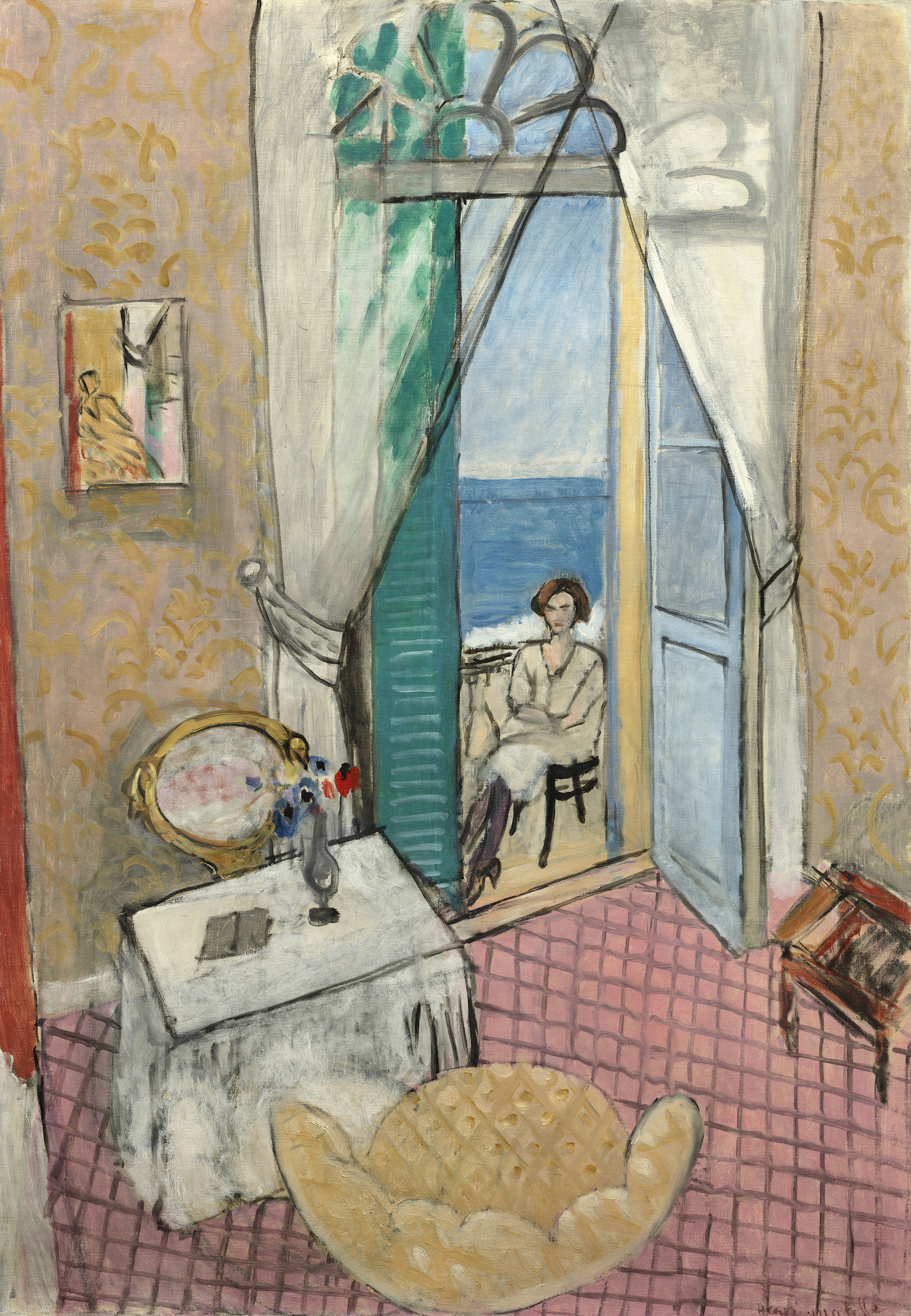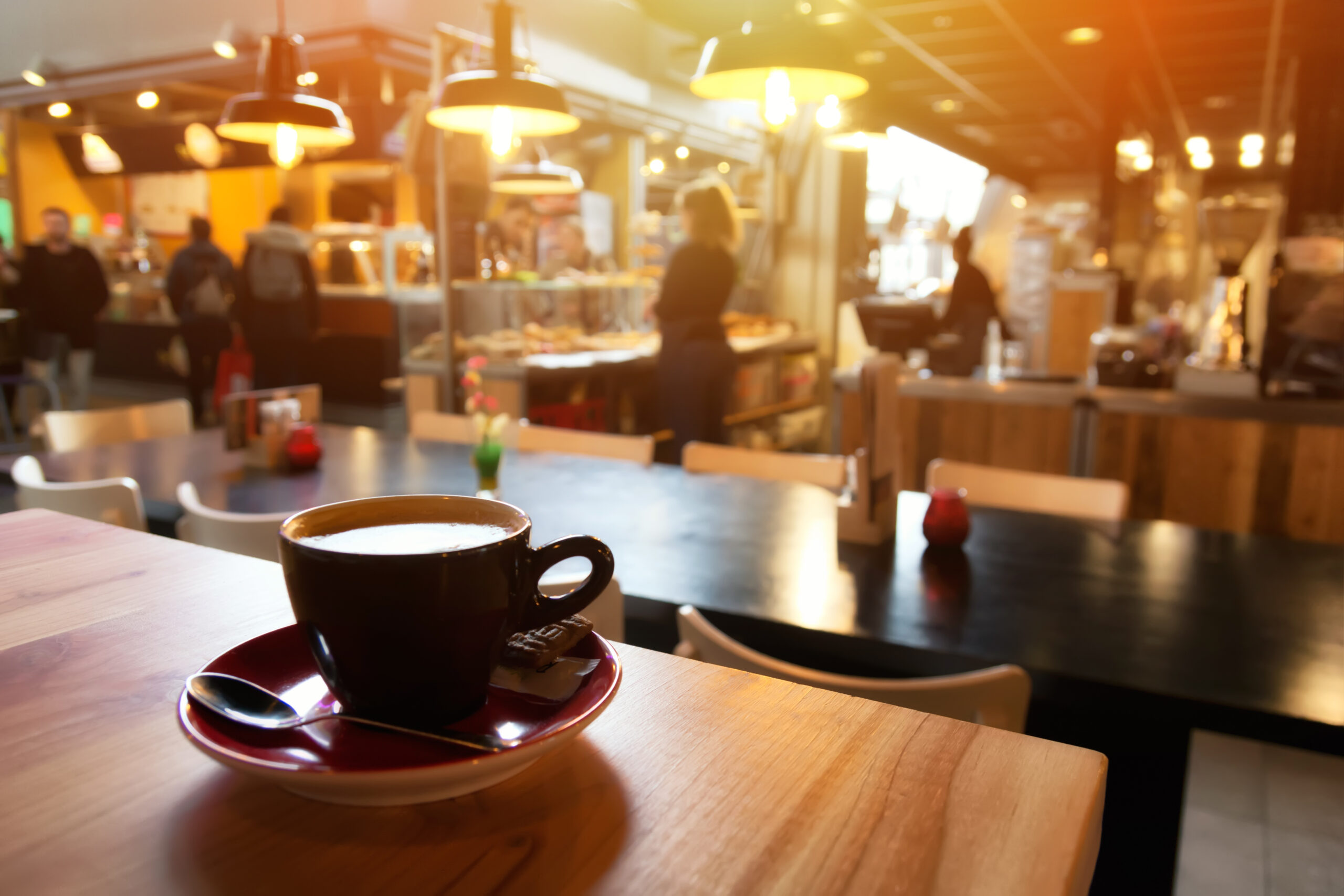The paintings may be best known for what they are not. They were made on the heels of work now considered Matisse’s most groundbreaking, the paintings from the period between 1907 and 1917 when he engaged with the early perceptions of modernism. His trajectory through these years widened his ambitions and shows him becoming more cutthroat within them, first leaving behind the saturated exuberance of fauvism, then, by degrees, flattening color and form into strange and austere near-abstractions. By the end he had left behind centuries of the painting traditions that he loved, and he was exhausted. In October 1917 he departed Paris for a winter in the south, soon arriving in the quiet seaside town of Nice. While he had made such recuperative trips before, this one became something different; it was his first visit to Nice, and his stay extended weeks, then months. “I feel myself a complete foreigner here,” he later wrote. The geographic isolation provided refuge from the chaotic closing stages of World War I, while the town’s unique presence—the “tender” quality of light and sweep of the Mediterranean, the theatrical chintz of the Hotel Beau-Rivage, where he took up residence—all delighted him: “Fake, absurd, amazing, delicious.” He would make Nice his primary residence, living and painting in the town, for the most part alone and away from his family, for the rest of his life.
The paintings he began making in Nice seemed to many an unaccountable step backward. Abstract experimentation quickly receded into scenes that were nearly postcard-familiar, rendered with what appeared to be impressionist naturalism. Many of the subjects were Matisse standards (portraits of women, still lives, landscapes), but what stood out as the most striking and representative images of his change in style were versions of the hotel rooms where he now made his home: sunlit, with a window on the ocean, sometimes empty and other times with a woman sitting languidly in the space. While conservative critics and many in the general public (and French State) welcomed the pictures as a return to the traditions of French painting, more progressive critics and artists were baffled. In the years that followed, as the modernist idea gathered momentum, so did dismissals of the early Nice work, negatively defining the period throughout Matisse’s lifetime and well past his death. The most repeated criticism could be summed up in the response of art historian Alfred Barr, who wrote that Matisse had “forgotten his own great past.” He was not advancing the cause but instead had retreated into “hedonistic, sensual, and charming art with no challenging or difficult moments—except for the painter.” Later, others would define the period as basically a long breather, allowing the master to regroup for the great work of the 1930s. Or the work was seen as a political expression, a nod to the “return to order” movement in Europe after the devastation of the war.
Matisse showed little interest in such analyses. “I don’t feel any bond with scholastic conventions or common sense.” He worked “without theory. I am conscious only of the forces that I use ….” On the influence of the war, he was in typical form, both blunt and reserved: “For those who could still work there was only a restriction of means, while for those who couldn’t work there was only a gathering of desires which they were able to gratify when peace returned.” Regarding the repeated charge of “naturalism,” he said the new work should be considered so only “if you can call it being a naturalist to listen to one’s memories and to the selective instinct that is so closely related to all creative talent.” He rarely admitted to disruption or incoherence in his at times radical changes of style; no matter what direction the paintings took, “my destination is always the same.”
In an interview in 1919, a little over a year after his arrival in Nice, Matisse gave an explanation, both direct and oblique: “… I am seeking a new synthesis … in which I have combined all that I have gained recently with what I knew and could do before.” That is, the advances he had made with his recent conceptual experiments would be joined with the direct emotional affect of fauvism. Spaces would be stylized, ornamental, but have a corporeality that could better convey a personal affinity and connection. Matisse went on to say that he wanted “to depict the typical and the individual at the same time, a distillation of all I see and feel in a motif.” What he chose as best illustrating this direction was the recently completed Interior with a Violin, and it’s easy to see why—the flattened planes and steeply pitched perspective clearly arise from his experimental period, while the deep contrasts and primary colors pop with fauvist intensity.
But, as a standard for his Nice project, the strongest example would be his first painting upon arrival, My Room at the Beau-Rivage. Like a majority of his work between late 1917 and (roughly) 1921, on first pass it is quiet and easily accessible. Look longer, however, and the painting’s elements seem to displace each other’s effects. The armchair is familiar and inviting, light falls tenderly on its surface, but the seat cushion slides outside its function and into an uncertain form, and the doily across the seatback shimmers and floats as if alive. The chair, like other forms in the room, becomes a liminal body, neither fully tactile (“the individual”) nor abstracted (“the typical”), and we find ourselves looking for anchors and wondering why. But what these paintings carried forward from Matisse’s previous work was not so much the confrontation with new forms as a new engagement with the space, activated when the viewer must reconcile all expectations of a recognizable world with the unexpected challenge of that world’s flux. By placing this engagement within a grounded, seemingly unchallenging representational approach, Matisse established a dynamic between artwork and viewer far beyond the vanguard of the time. If modernism was positing a new description of reality, the paradox Matisse had invited us into was that of a deeply familiar reality whose own assumptions no longer applied.
Matisse had always wanted his paintings to express a particular kinship with the viewer. His goal was intimacy—“to give the spectator the feeling that the artist is a sensitive and generous being.” What created this connection was the “human element,” also referred to by Matisse as “human values” or “true values,” qualities inherent in subjects that viewers knew from their own lives: landscapes, portraits, still lives, etc. Challenges to this premise had been made by the European avant-garde before the war, but during it, and in the years following, the questions grew more complex. Should modern painting realign to support those values so compromised by the conflict? If these modes were beyond salvaging, what could take their place as a vehicle for emotional meaning? If meaning itself was outdated, would form alone be merely decorative?
Publicly, Matisse shrugged off most of these squabbles (“These preoccupations are foreign to painting”), but his wide view took in all sides. He knew that in the rigor of his experiments with abstraction he had given up much of the emotional affirmation that he considered essential. And he knew that overreliance on naturalism could easily tip a painting into sentimental anecdote. But if he was searching for a new model of expression in the early Nice work, his destination was unchanged: the focus remained on the object as a source of sensation and therefore connection. Be it representational or abstracted, the more successfully the object communicated its “essential truth” (which, according to Matisse, “must be disengaged from the outward appearance” of what was represented), the stronger and more timeless the emotional connection to the viewer. Sentimental narrative and heady conceptualism—both bound to social and cultural taste—were areas in which Matisse had little interest. He instead strove to depict the object as “isolated from its milieu”—the only way to free its power to move forward in time. “A work of art has different significance for each period in which it is examined. … In each period, a work of art brings to man the pleasure that comes from communion between the work and the man viewing it. If the spectator renounces his own quality in order to identify himself with the spiritual quality of those who lived when the work of art was created, he impoverishes himself and disturbs the fullness of his pleasure ….”
It was not until nearly seventy years after Matisse introduced the “new synthesis” that he was attempting in Nice that critics began to reach a consensus on the importance of the pictures. In his 1986 essay accompanying the first complete exhibition and catalogue of the Nice paintings, Dominique Fourcade discusses the work as a “statement of a new unity and a new surface stability through the use of light” that moves beyond the reconfiguration of space found in the preceding period of abstraction. In her essay for the 2012 exhibition catalogue Matisse: In Search of True Painting, Dorthe Aagesen writes how Matisse “skillfully and eloquently links his previous work on simplifying forms with the immediacy of sensation that was part of the Impressionist legacy.” Here is the synthesis that Matisse had planned, with the line of analysis in many ways mirroring Matisse’s own: a strict focus on formal problem-solving, the artist’s personal motivations subsumed into aesthetic terms, all aesthetic conflicts resolved harmoniously. (As Aagesen quotes him: “A will to rhythmic abstraction was battling with my innate desire for rich, warm, generous colors and forms …. From this duality issued works that, overcoming my inner constraints, were realized in the union of poles.”) However, in the last paragraph of his essay, after pages of celebratory praise, Fourcade makes a sly shift. The many images of empty rooms and women alone build into something unexpected, darker, and more personal. “Obsessions filter through and anguish emanates from the succession of images … the depicted world is one of waiting and sadness; a world of heavy eroticism, almost a world of the voyeur. A distant world, in which communication seems impossible, or futile … the world indefinitely repeated in a kind of insistent existential loss. As if the light one had obtained had resulted in nothing but solitude, and demanded a fatal renunciation.”
Matisse did not encourage connections between his work and private life (“My canvases speak for me”), but to further develop the perceptions Fourcade touches on—in particular the role of spectator or “voyeur,” the effect that watching has on consciousness, and vice versa—it’s important to examine the complicated way Matisse saw himself in the world. Like any artist, he understood his internal source. “In painting—in any oeuvre—the goal is to reconcile the irreconcilable. There are all kinds of qualities in us, contradictory qualities. You have to construct something viable with that, something stable.” The side of him that was best known and that he made public was this stability: a deeply cultivated reserve and pragmatism, deliberately showing little interest in bohemian lifestyles or avant-garde theories. He jokingly pleaded with a journalist that she should tell her American audience that he was a normal man “just like any man.” His famous statement, written early in his career, that described his ideal as “an art of balance, of purity and serenity, devoid of troubling or depressing subject matter … something like a good armchair that provides relaxation from fatigue” is still used by both admirers and detractors to buttonhole his work. It links as easily to Barr’s criticism of the Nice interiors—“charming art with no challenging or difficult moments”—as it does to much of Aagesen’s and Fourcade’s praise.
The side that Matisse tended not to make public was a deep and restless uncertainty. Signs show through, sometimes sharply—“All my life I’ve been terrified, terrified not to fulfill my duty to painting”—or casually, as in his offhand mention of lifelong insomnia. Spend time in his writings and interviews, however, and it’s the constant, intense formality that points most clearly to all he kept in check. In a critique of a suite of his own self-portraits, Matisse allowed himself to expose his tension, at the same time keeping a careful remove: “This ensemble of elements describes the same man, in terms of his character … in terms of the reserve he displays in relation to life which keeps him from uncontrolled surrender to it. It is indeed the same man, who always remains an attentive spectator of life and of himself.” The moment’s mix of control and vulnerability expresses contradictions many artists recognize: how one can both draw from and be overwhelmed by a powerful sensitivity, how efforts to manage the sensitivity can intensify its volatility. When Matisse was asked late in his life if he believed in God, he answered, “Yes, when I work. When I am submissive and modest, I sense myself helped immensely by someone who makes me do things that surpass myself. Still, I feel no gratitude toward Him because it is as if I were watching a conjurer whose tricks I cannot see through. I then find myself thwarted of the profit of the experience that should be the reward for my effort. I am ungrateful without remorse.”
No artist’s practice has final authority or complete submission; it’s defined by a circling between these two extremes. Matisse’s many passionate and detailed explanations of his aesthetic planning and technique are usually punctuated by his acknowledgment of an underlying intelligence he could never understand. “I believe only in instinct. It is the purest, most invulnerable thing, the true lifespring of artistic activity.” “I, who let myself always be guided by my instinct (so much so that it manages to overcome my reason) ….” “I follow my inner feelings as closely as possible. Thus all the intellectual part of my work is secondary and very little evident.” Meanwhile, he would regularly repaint his most successful canvases “to be sure that one has not been the plaything of one’s nerves or chance.”
Again, the push/pull between conceptual control and intuitive impulse is nothing new—it’s how art gets made. But this tension within art-making is more accurately a tension within seeing. The ability to judge whether or not what arises in the process of making an artwork is necessary for its fulfillment is the most central skill in an artist’s practice. It’s also what connects the work to the spectator, for when a viewer is convinced of the inevitability of the finished piece, he or she is operating on a level equal with the artist. Both engagements involve an inherent instability. As Matisse explained, the source of a work’s success is many times unclear, with a spectrum of alternative choices waiting in the wings. While both the artist and the spectator actively seek stability in the work (the “art of balance”), the threat of its collapse is just as vital (as the more real the threat, the more stability counts and the more vitality is generated). In the early Nice interiors, this visual navigation between control and intuition was an intense preoccupation, but it was focused not so much on the nature of the depiction as on the nature of the viewer. The self as spectator described by Matisse in the previous quotes, an active participant and removed observer, receiving and connected to all but never fully understanding, is central to the formal and emotional issues of the paintings. In this body of work, more than any other he made, each element brings us back to the enigmatic act of seeing.
The dichotomy created (and solved) by the spectator had been explored by Matisse before. In his earlier fauvist and semiabstract works, the viewer is engaged in negotiating the painting as a surface. But in the early Nice interiors we are immediately pulled into a familiar space. Looking at the paintings becomes an act of physical orientation, and perspective is the hook. Most of the spaces ground us in the center of the scene, in Matisse’s shoes, with the pitched floors and ceilings (and, in The Bay of Nice, land and water) sliding under and over us, emphasizing the shared point of view and further concentrating the vistas framed by a window or balcony. Every part of the construction invites the movement of the eye, from the telescoping outward push via the emblematic “views,” to the intimate sense of ownership within the domestic motif—we know where we are, that these are rooms we can move through as we wish. Yet we’re immobilized. The skew of perspectival lines that draws us in equally pushes us back, turning these navigable spaces into subtle, sticking webs. The pitched perspective is not nearly as extreme as in his experiments prior to Nice, but while those earlier paintings are dramatic confrontations with observed reality, these quieter distortions rewire our personal reality. Locked in place, a comfortable world just out of reach, we look for connections. The models Matisse occasionally places in the rooms provide none. Their faces are distracted, unfocused, sometimes startlingly erased. We’re repeatedly forced back on ourselves.
Looking becomes a closed circuit. The moment our gaze rests on the items in the rooms, they quietly shift beyond our expectations. We adjust (with subliminal speed), and they shift again. The encounters vary. The impossibly tipped chair in Large Interior, Nice, floating on the bottom of the picture frame, is somehow also resting comfortably within the room. In the window view in My Room at the Beau-Rivage, the sky folds like a cloth over the sea’s horizon. The moments repeat and switch in scale. The abrupt erasures seen in the models also wipe away a tablecloth in Large Interior, a curtain in My Room…, a palm tree in The Bay of Nice, and a hovering, vibrating chaise in Two Women in an Interior that melds with the barely-there figure resting on it. The power of these moments comes not so much through variety or surprise as through accumulation—they don’t stop. The possibilities multiply as one experience arises into the next; we’re kept circling in the spaces without ever gaining purchase, and our initial comfort is laced with the anxiety of displacement.
The movement is most subtly made through color and light; here Matisse’s mastery is on full display. The translucence, looseness, and speed of the marks, the glowing signs of white canvas below, the pulsing palette, all create a freshness that personifies the setting. As Fourcade writes, “Each site of color becomes a source of light that, combined with all the other sources of light on the canvas, create a wholeness of light and space.” Again, impressions are immediately confounded. The dominant color relationships in many of the hotel paintings are between exterior blues and interior yellows, but the temperatures are strangely reversed: the ocean and sky are the warmest areas and the interior yellows, normally associated with warmth and openness, suggest anything but. Matisse achieves this disconcerting switch quietly, with expert juxtapositions of color and mixing of hues that tip each side over to the other, creating a climate in flux that further suspends the viewer within the duality of the space. We are welcomed and refused. The women are relaxed company and formal strangers. The hotel rooms are private, full of personal comforts, and also steeped in transience.
Of all his color, Matisse’s use of black in the Nice paintings connects us most directly with these tensions. The artist’s powerful blacks became subtler in Nice. Matisse called them a “ballast,” a counterweight for the floating wash of light and color. Unlike his handling of the rest of his palette, his black strokes are usually rough, but their shapes hold the space together and, as many critics have pointed out, strengthen and focus the famous light. Paradoxically, the blacks never dominate or feel out of place. Matisse recounted that when Renoir first saw My Room at the Beau-Rivage, he was astonished that the black in the window cornice was the dominant tone yet “didn’t press into the foreground but stayed where its position in the room dictated. … I couldn’t find an explanation on the spot and yet the explanation is very simple …. The space is constructed by a set of forces that has nothing to do with copying directly from nature.” The only further clarification Matisse could offer involved “quite a bit of mysterious instinct that comes into this construction.” The blacks serve the color by being its opposite, and the color takes us directly to the blacks, its haunting absence.
This experience of negation was examined by Alastair Wright in his book Matisse and the Subject of Modernism. Focusing on the period between 1905 and 1913 when Matisse moved from fauvism to his beginning experiments in abstraction, Wright proposes that the range of techniques and concepts between and within these paintings, considered incoherent by many critics of the day, demonstrate a “fundamental indeterminancy,” a precarious subjectivity that marks them as modernist works before their time. Wright will not, however, extend this interpretation to the early Nice work, which he sees as a return to “the easy relationship between viewer, painter and subject.” To Wright, the subjects in these paintings are “profoundly untroubling.” But this is exactly the source of their disruptive power. Consciously or unconsciously, Matisse came to Nice and stripped parts of himself away. He left behind his family and home, the city that held him in acclaim, advances in his work that many considered groundbreaking. He called it a “decantation.” After the intense years of ambitious experimentation toward what he had hoped would be “an unprecedented creation,” as well as a terrible war that directly threatened his family and his cultural tradition—the ballasts of a carefully balanced life—what remained is revealed starkly in the work: the basic act of standing in a room and painting. The naturalistic rendering and familiar subject matter are critical because they invite us to enter that environment as the artist did. We look as he looks, connecting through his eyes with that “human element” so important to him, to which he was finally returning. But now the element has changed. “A distillation of all I see and feel” has expanded from a description into an event. It is beauty and comfort as well as dislocation and sadness, with each side weighed against the other until what’s left is a void, full of light, holding everything and concluding nothing.
The opening up of space through negation releases these paintings into an area far beyond Wright’s “fundamental indeterminancy,” creating contradictions that wouldn’t be fully explored for decades. Perhaps the most direct comment on the era in which they were made is the way the pictures gain strength by demonstrating their vulnerability. The provisional renderings, unset styles, and banal settings are not just a rebuttal of the heroic new “truths” being championed in early modernism (which Matisse had just spent “long, wearying years” testing and retesting); they also expose the failure of heroism itself that lay within the movement. Here, truths are revealed as relative to a subjective point of view, apparent meanings often mask their opposites, and no moral position or sense of “art as progress” is feasible. The marrying of this uncertainty with a familiar world is what opens the paintings to our current time. These mundane objects and environments are mediators. Their everyday role allows easy attachment—they welcome our need for place, identity, comfort, etc. But these clear definitions occupy the same space as a deep, quiet instability—that “essential truth” so critical to Matisse that shows any definition as impossible to set, as illusory as the “fake, absurd” rooms that he chose to paint. The circling of these two sides, bound together more closely in the Nice interiors than in any other moment of his career, create a concentrated volatility that reveals how much these needs of ours are fundamentally constructs, how separated we’ve become from what’s actually before us, and how we’ve failed to even notice our estrangement. An “insistent existential loss,” as Fourcade described in his conclusion, but it is not the only outcome. Our recognition of the spaces is also a creative act—it grants them their unexpected force and elevates us into co-creators, into the reality of Matisse’s vision, a rare place to be.
The opening created by the work was brief. By the early 1920s, the alert, emptied quality of the early interiors gave way to a tactile weight, a sense of pleasure in materials and subject matter. Paintings became richly crowded with pattern, and models became center-stage odalisques. This new density pushes the viewer back, as we start to negotiate the physicality and hierarchy of the space as opposed to questioning its actual nature. Matisse’s decision to move away from the early Nice style was no doubt similar to how he came into it: partly intellectual choice, mostly instinctual reaction. About the initial change that accompanied his move to Nice, he explained, “I have always understood which way I should go. I have never for a moment strayed from it, and I see now that it leads to the goal, my goal.” As in the description of his self-portraits, the small twist in the statement goes deep. The goal is something he senses but can never know, that will perhaps never be fully seen but only added to in the years to come. The work is born out of the hard-won conceptualism that came before it, which, for all its idealistic possibilities, proved to be too narrow a path. The force of his reaction—perhaps further fueled by the shock of war, as well as the shock of normalcy following it—was such that rather than expanding these ideas, it briefly and completely propelled him beyond them. As in all his best work, this move radiates toughness, risk, and faith, and his embrace of uncertainty is the profound heart of his genius. “There are so many things I would like to understand, and most of all myself,” he explained toward the end of his career. “After a half century of hard work and reflection the wall is still there. Nature—or rather my nature—remains mysterious. Meanwhile I believe I have put a little order in my chaos by keeping alive the tiny light that guides me and still energetically answers the frequent enough SOS. I am not intelligent.”
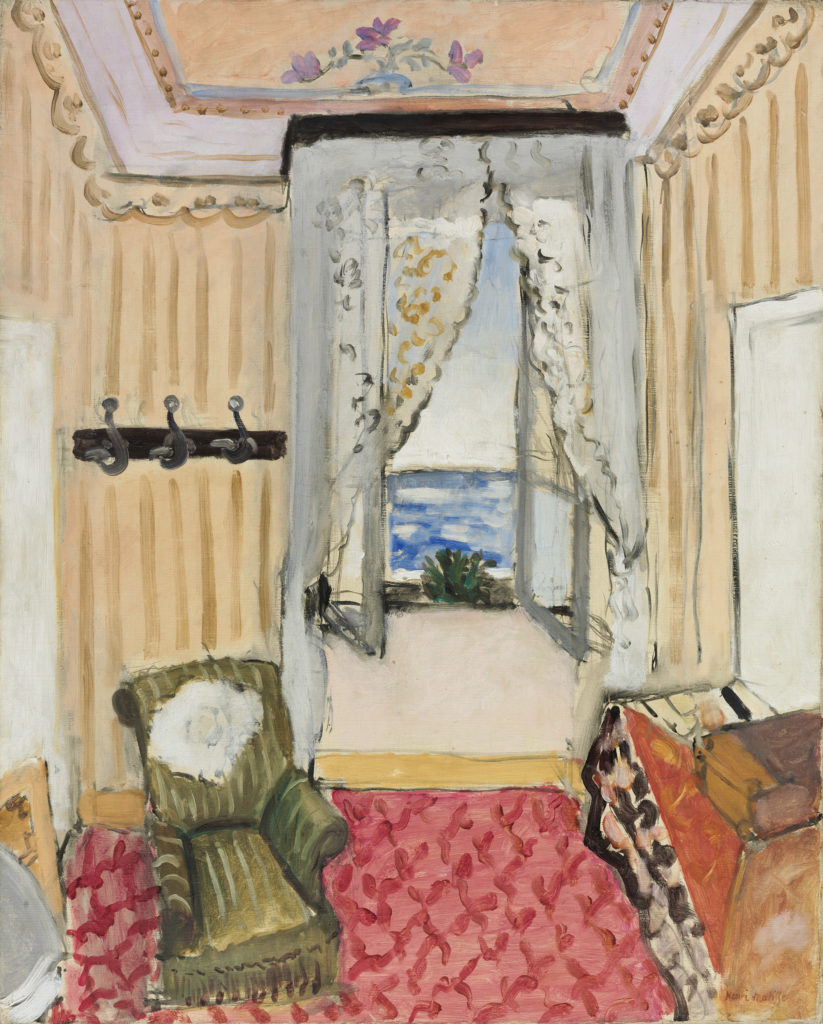 My Room at the Beau-Rivage. 1917-1918.
My Room at the Beau-Rivage. 1917-1918.
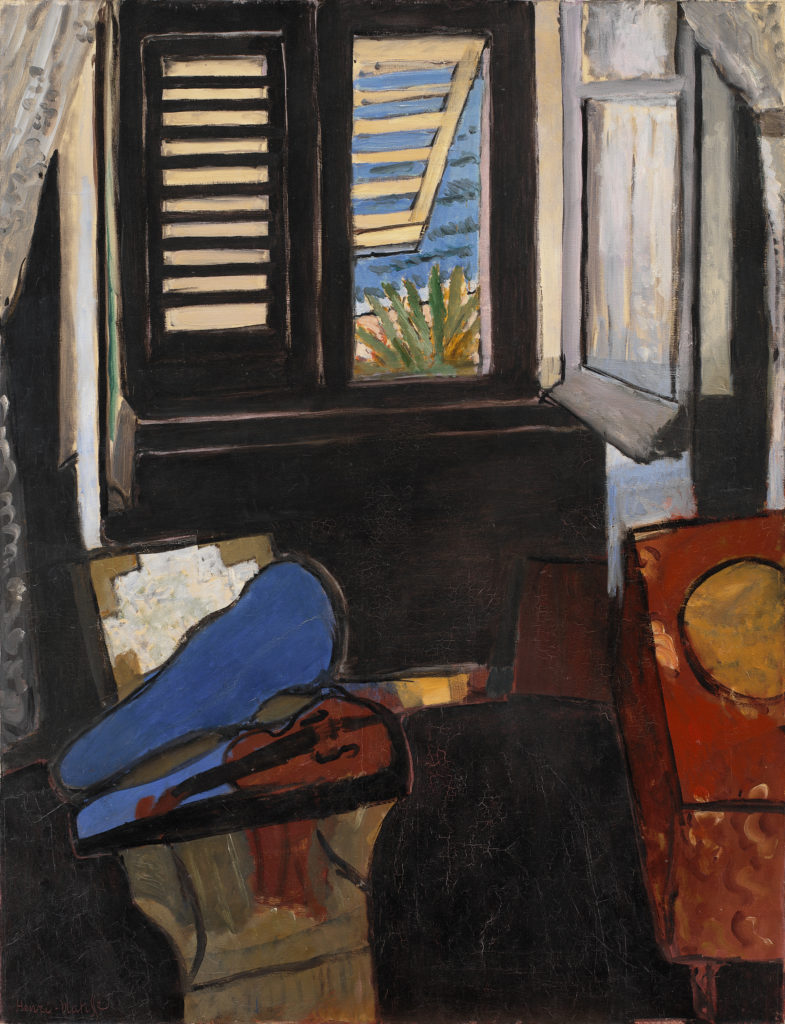
Interior with a Violin. 1917-1918.
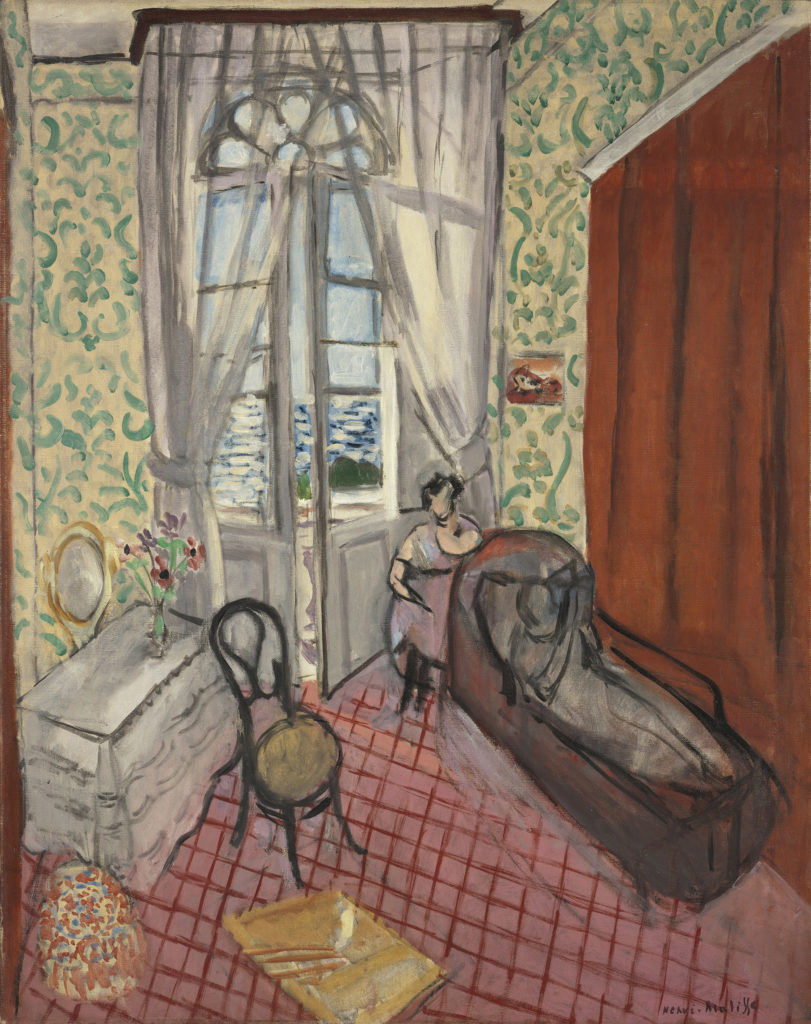
Two Women in an Interior. 1920-1921.
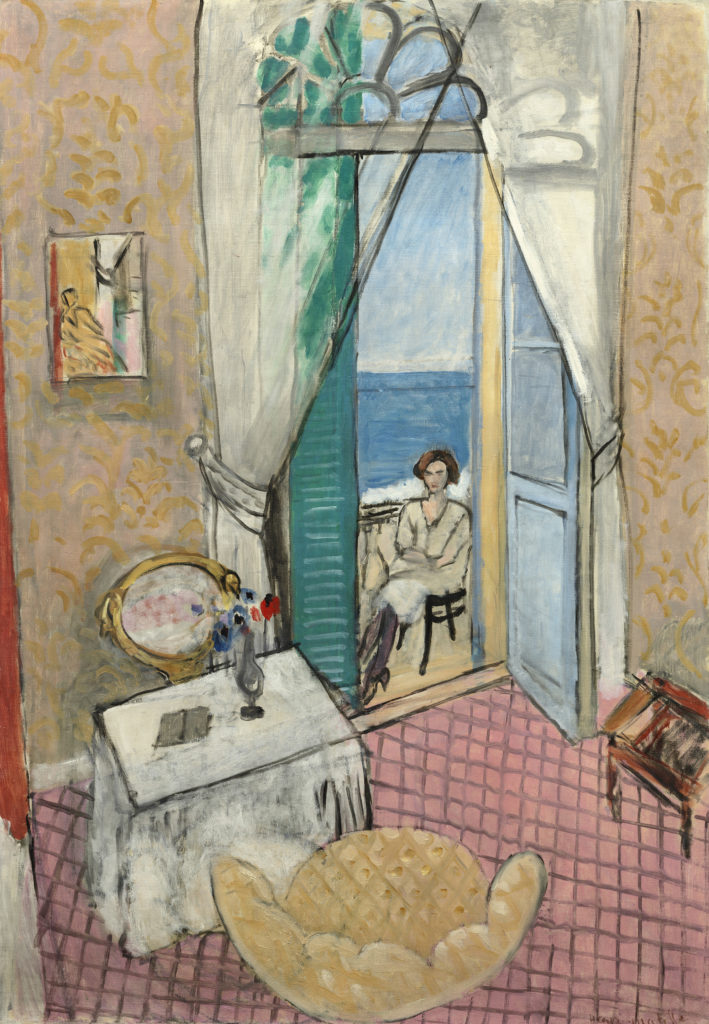 Large Interior, Nice. 1918-1919.
Large Interior, Nice. 1918-1919.
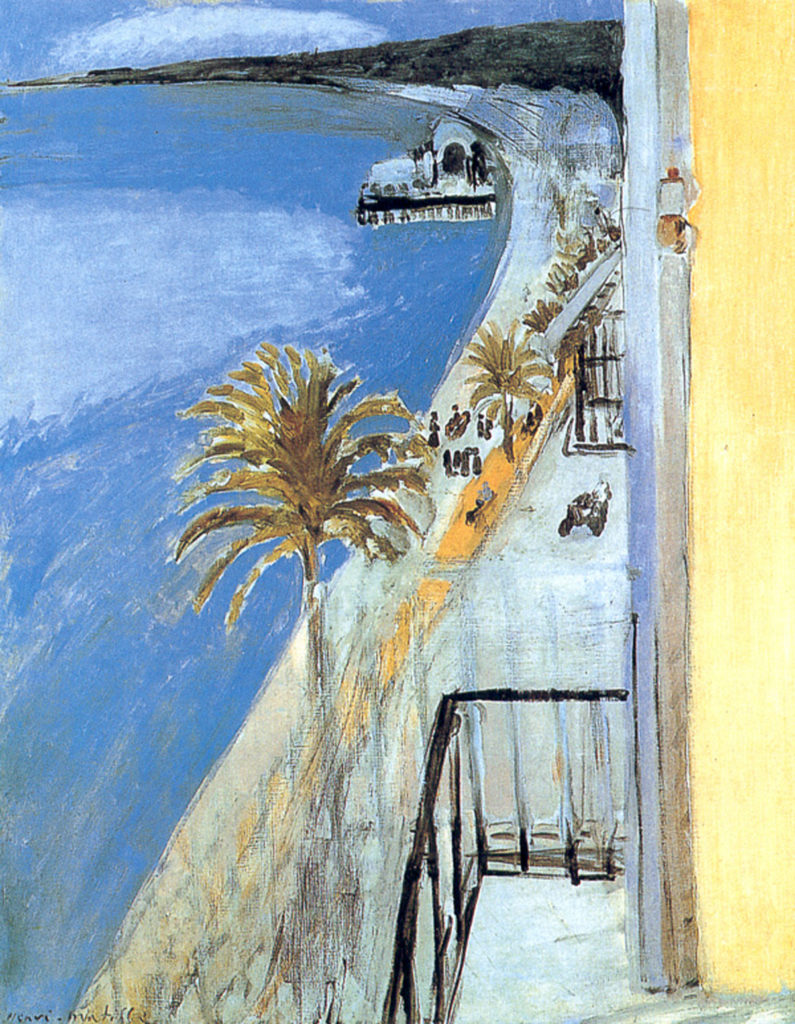 The Bay of Nice. 1918.
The Bay of Nice. 1918.
Arden Hendrie is a visual artist living in Albuquerque, NM. He thanks Susan Hammond for her invaluable help in writing this essay.
Bibliography:
Aagesen, Dorthe. “Painting the Light.” In Matisse: In Search of True Painting, ed. Dorthe Aagesen and Rebecca Rabinow. New York: Metropolitan Museum of Art, 2012.
Barr, Alfred H., Jr. Matisse: His Art and His Public. New York: Museum of Modern Art, 1951.
Bock-Weiss, Catherine. Henri Matisse: Modernist Against the Grain. University Park: The Pennsylvania State University Press, 2009.
Courthion, Pierre. Chatting with Henri Matisse: The Lost 1941 Interview, ed. Serge Guilbaut. London: Tate Publishing, 2013.
Degand, Léon. “Matisse á Paris.” Les Lettres françaises, 6 (October 1945): 1–4.
Flam, Jack, ed. Matisse on Art. Berkeley: The University of California Press, 1995.
Fourcade, Dominique. “An Interrupted Story.” In Henri Matisse: The Early Years in Nice, 1916–1930, ed. Jack Cowart. New York: Harry N. Abrams, Inc., 1986.
Giraudy, Daniéle. “Correspondance Henri Matisse-Charles Camoin.” La Revue de l’art, 12 (1971): 7–34.
Hoppe, Ragnar. “Pa visit hos Matisse.” In Städer och Konstnärer: resebrev oche essäer om konst. Stockholm: Bonnier, 1931.
MacChesney Clara. “A Talk with Matisse, Leader of Post-Impressionists.” New York Times Magazine (March 9, 1913).
Matisse, Henri. “L’exactitude n’est pas la vérité.” In Henri Matisse: Dessins. Paris: APIAW, 1947.
Matisse, Henri. “Notes d’un peintre.” La Grande Revue, II, 24 (December 25, 1908): 731–745.
Matisse, Henri. “Océanie, tenture murale.” Labyrinthe, II, 3 (December 1946): 22–23.
Matisse, Henri. “Témoignages de peintres: Le noir est une couleur.”Derrière le miroir,
(December 1946): 6.
Matisse, Henri, Marie-Alain Couturier, and L. B. Rayssiguier. La chapelle de Vence: Journal d’une création. Marcel Billot, ed. Milan: Skira, 1933.
Sacs, J. “Enric Matisse.” Vell I nou, 1 (November 1919).
Severini, Gino. “La peinture de l’avant-garde.” In Témoignages: 50 ans de réflexion. Rome: Art Moderne, 1963. Originally published in Mercure de France, 121 (June 1917).
Spurling, Hillary. Matisse the Master: A Life of Henri Matisse: The Conquest of Colour 1909–1954. New York: Knopf, 2005.
Tériade, E. “Matisse Speaks.” Art News Annual, 21 (1952): 40–71.
Tériade, E. “Visite á Henri Matisse.” L’Intransigeant, 14 & 22 (January 1929).
Verdet, André. “Entretiens avec Henri Matisse,” In Prestiges de Matisse, Paris: Éditions Emile-Paul, 1952.
Verdet, André. Entretiens, notes et écrits sur la peinture: Braque, Léger, Matisse, Picasso. Paris: 1978.
Wright, Alastair. Matisse and the Subject of Modernism. Princeton: Princeton University Press, 2004.
